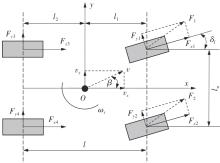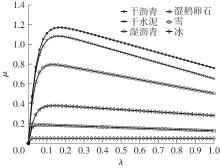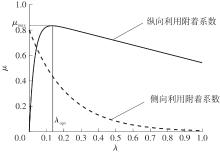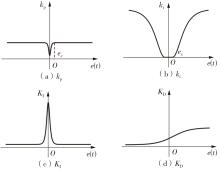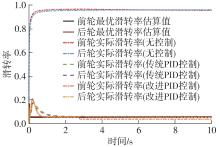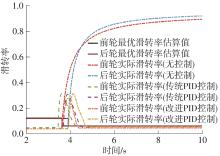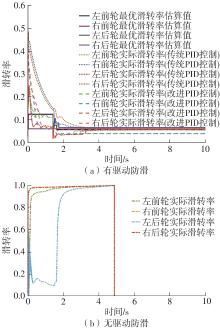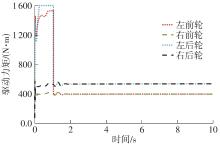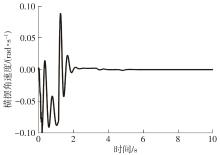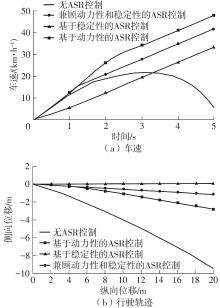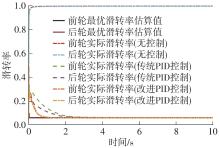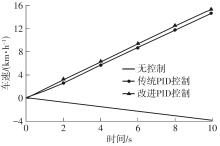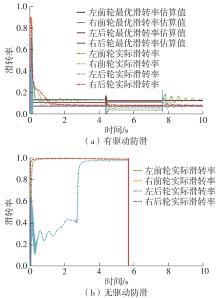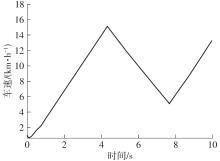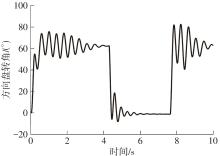Journal of South China University of Technology(Natural Science Edition) ›› 2025, Vol. 53 ›› Issue (6): 44-55.doi: 10.12141/j.issn.1000-565X.240330
• Vehicle Engineering • Previous Articles Next Articles
Design of Acceleration Slip Regulation Multi-Mode Control Strategy of Distributed Drive Electric Vehicle
ZHU Shaopeng1,2( ), MAO Jingyang1, LIU Dongqing3, YIN Yuming4, CHEN Huipeng5, XU Yekai1
), MAO Jingyang1, LIU Dongqing3, YIN Yuming4, CHEN Huipeng5, XU Yekai1
- 1.Power Machinery & Vehicle Engineering Institute,Zhejiang University,Hangzhou 310027,Zhejiang,China
2.Jiaxing Research Institute,Zhejiang University,Jiaxing 314011,Zhejiang,China
3.CRSC Research & Design Institute Group;Co. ,Ltd. ,Beijing 100070,China
4.College of Mechanical Engineering,Zhejiang University of Technology,Hangzhou 310023,Zhejiang,China
5.School of Mechanical Engineering,Hangzhou Dianzi University,Hangzhou 310018,Zhejiang,China
-
Received:2024-06-26Online:2025-06-10Published:2024-09-27 -
Supported by:the National Key Research and Development Program of China(2022YFB2502400)
CLC Number:
Cite this article
ZHU Shaopeng, MAO Jingyang, LIU Dongqing, YIN Yuming, CHEN Huipeng, XU Yekai. Design of Acceleration Slip Regulation Multi-Mode Control Strategy of Distributed Drive Electric Vehicle[J]. Journal of South China University of Technology(Natural Science Edition), 2025, 53(6): 44-55.
share this article
| 1 | 王震坡,丁晓林,张雷 .四轮轮毂电机驱动电动汽车驱动防滑控制关键技术综述[J].机械工程学报,2019,55(12):99-120. |
| WANG Zhenpo, DING Xiaolin, ZHANG Lei .Overview on key technologies of acceleration slip regulation for four-wheel-independently-actuated electric vehicles[J].Journal of Mechanical Engineering,2019,55(12):99-120. | |
| 2 | 李静,李幼德,赵健,等 .四轮驱动汽车牵引力控制系统研究[J].吉林大学学报(工学版),2003,33(4):1-6. |
| LI Jing, LI You-de, ZHAO Jian,et al .Research on traction control system for four wheel drive vehicle[J].Journal of Jilin University (Engineering and Technology Edition),2003,33 (4):1-6. | |
| 3 | 常九健,吴佳豪,方建平 .基于路面识别算法的分布式驱动汽车驱动防滑控制策略[J].重庆理工大学学报(自然科学),2024,38(2):65-76. |
| CHANG Jiujian, WU Jiahao, FANG Jianping .Research on acceleration slip regulation strategy based on road surface recognition algorithm[J].Journal of Chongqing University of Technology (Natural Science),2024,38(2):65-76. | |
| 4 | KATO M .Proposal of anti-slip control method for electric vehicles with adaptive torque limiter[C]∥Procee-dings of the JSAE Annual Congress (Spring).Yokohama:JSAE,2013:1-4. |
| 5 | 梅中祎 .电驱动客车驱动防滑控制方法及关键问题研究[D].北京:北京林业大学,2022. |
| 6 | 张博涵,陈哲明,付江华,等 .四轮独立驱动电动汽车自适应驱动防滑控制[J].山东大学学报(工学版),2018,48(1):96-103. |
| ZHANG Bohan, CHEN Zheming, FU Jianghua,et al. Self-adaption acceleration slip regulation control of four-wheel independently-driving electric vehicle[J].Journal of Shandong University (Engineering Science),2018,48(1):96-103. | |
| 7 | 李杰 .分布驱动式纯电动汽车驱动防滑控制策略[D].太原:太原科技大学,2022. |
| 8 | 罗浩 .分布式驱动电动汽车驱动防滑控制策略研究[D].北京:北京理工大学,2016. |
| 9 | 张伦 .轮边电机驱动电动汽车驱动防滑控制的研究[D].南京:东南大学,2019. |
| 10 | 赵永强 .四轮轮毂驱动电动汽车扭矩优化分配方法的研究[D].长春:吉林大学,2021. |
| 11 | PACEJKA H B, BAKKER E .The magic formula tyre model[J].Vehicle System Dynamics,1992,21:1-18. |
| 12 | 孙大许,兰凤崇,何幸福,等 .双电机四轮驱动电动汽车自适应驱动防滑控制的研究[J].汽车工程,2016,38(5):600-608,619. |
| SUN Daxu, LAN Fengchong, HE Xingfu,et al .Study on adaptive acceleration slip regulation for dual-motor four-wheel drive electric vehicle[J].Automotive Engineering,2016,38(5):600-608,619. | |
| 13 | BURCKHARDT M .Fahrwerktechnik:radschlupf regelsyste me[M].Würzburg:Vogel,1993. |
| 14 | CHEN L, BIAN M Y, LUO Y G,et al .Real-time identification of the tyre-road friction coefficient using an unscented Kalman filter and mean-square-error-weighted fusion[J].Proceedings of the Institution of Mechanical Engineers,Part D:Journal of Automobile Engineering,2016,230(6):788-802. |
| 15 | GUSTAFSSON F .Slip-based tire-road friction estimation[M].London:Pergamon Press,Inc,1997. |
| 16 | 魏来 .电动汽车驱动防滑控制方法研究[D].沈阳:沈阳工业大学,2016. |
| 17 | 宋炳潭,孙宾宾,葛文庆,等 .双电机电动汽车驱动防滑转控制策略研究[J].现代制造工程,2021(10):11-16,39. |
| SONG Bingtan, SUN Binbin, GE Wenqing,et al .Research on acceleration slip regulation control strategy of dual-motor electric vehicle[J].Modern Manufactu-ring Engineering,2021(10):11-16,39. | |
| 18 | 朱文静,李刚,姬晓 .四轮独立驱动电动汽车驱动力矩分配方法[J].重庆理工大学学报(自然科学),2022,36(3):41-47. |
| ZHU Wenjing, LI Gang, JI Xiao .Driving torque distribution method for four-wheel independent drive electric vehicle[J].Journal of Chongqing University of Technology (Natural Science),2022,36(3):41-47. |
| [1] | BI Jun, WANG Jianing, WANG Yongxing. Short-Term Operation State Prediction of Charging Station Based on LSTM-FC Model [J]. Journal of South China University of Technology(Natural Science Edition), 2025, 53(2): 58-67. |
| [2] | SHANGGUAN Wenbin, YUE Lian, LÜ Hui, et al. Fatigue Test and Calculation Methods for Battery Package Based on Load Spectrum [J]. Journal of South China University of Technology(Natural Science Edition), 2024, 52(3): 50-56. |
| [3] | DONG Ping, WEI Shuyang, LIU Mingbo. Scheduling Strategies for Electric Vehicle Participation in Electricity Markets Under Multi-Network Collaboration [J]. Journal of South China University of Technology(Natural Science Edition), 2023, 51(12): 83-94. |
| [4] | PEI Mingyang, ZHU Hongyu. Modeling Method for Optimizing Dynamic Wireless Charging Lane of Electric Vehicles [J]. Journal of South China University of Technology(Natural Science Edition), 2023, 51(10): 135-151. |
| [5] | LUO Yutao, WU Zhiqiang . Online Joint Estimation of Main States of Lithium-Ion Battery Based on DAEKF Algorithm [J]. Journal of South China University of Technology(Natural Science Edition), 2023, 51(1): 84-94. |
| [6] | LÜ Hui, ZHAO Jiawei, MAO Haikuan, et al. Analysis of the Powertrain Mount Systems of Electric Vehicles by Considering the Correlation of Probabilistic Parameters [J]. Journal of South China University of Technology(Natural Science Edition), 2022, 50(3): 65-72. |
| [7] | ZHANG Xin CUI Yuxuan XUE Qicheng. Torque Coordinated Control Strategy of PHEV Engine Starting in Motion Process [J]. Journal of South China University of Technology(Natural Science Edition), 2021, 49(8): 129-139. |
| [8] | LIU Hanwu, LEI Yulong, FU Yao, et al. Adaptive Regenerative Braking Control Strategy of Range-Extended Electric Vehicle Based on Multi-Objective Optimization [J]. Journal of South China University of Technology (Natural Science Edition), 2021, 49(7): 42-50,65. |
| [9] | GUO Lie, GE Pingshu, XU Linna, et al. Stability Control for Distributed Drive Electric Vehicle Under Steering Condition [J]. Journal of South China University of Technology (Natural Science Edition), 2020, 48(3): 100-107. |
| [10] | YANG Jinming SUN Jieshan LIU Runpeng. Passivity-Based Control of Primary-Side and Secondary-Side Rectifier Bridge in Wireless Power Transfer System for Electric Vehicle [J]. Journal of South China University of Technology(Natural Science Edition), 2020, 48(10): 11-18,47. |
| [11] | QIN Datong QIN Ling. Energy Management Strategy for a Power-split Hybrid Electric Vehicle Based on Explicit Stochastic Model Predictive Control [J]. Journal of South China University of Technology(Natural Science Edition), 2019, 47(7): 112-120. |
| [12] | YAO Mingyao ZHANG Xiaoxing QIN Datong. Real-Time Optimization of Equivalent Factor for Plug-in Hybrid Electric Vehicle [J]. Journal of South China University of Technology (Natural Science Edition), 2019, 47(11): 44-53. |
| [13] |
YAN Junhua WANG Shuxiao YUAN Haoran CHEN Yong SHAN Rui.
Life Cycle Assessment of Energy Consumption with Emission and Environmental Impact of Electric Vehicle
[J]. Journal of South China University of Technology (Natural Science Edition), 2018, 46(6): 137-144.
|
| [14] | XIONG Huiyuan HE Shan ZHA Hongshan ZHU Xionglai. Control Strategy of Driving Torque Distribution for Two-Axle Drive Electric Vehicles#br# [J]. Journal of South China University of Technology(Natural Science Edition), 2018, 46(11): 117-124. |
| [15] | QIN Datong LIU Xingyuan LUO Song. Comprehensive Performance Optimization of PHEV Considering CVT Ratio Jumping in Mode Switching Process [J]. Journal of South China University of Technology (Natural Science Edition), 2018, 46(1): 85-90,111. |
| Viewed | ||||||
|
Full text |
|
|||||
|
Abstract |
|
|||||
